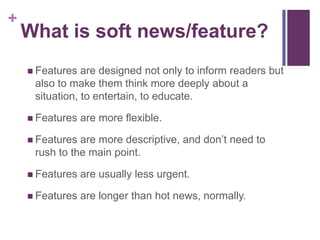
The art of writing soft news has been a subject of much discussion among journalists and writers for years. Soft news, also known as feature articles, is a style of news writing that focuses on human interest stories, arts and entertainment, lifestyle, and other non-hard news topics. This style of writing allows writers to closely connect with their readers and show their creative side.
When writing soft news articles, it is important to structure your writing in a way that captures the reader’s attention from the beginning. One of the best ways to do this is by using a catchy lede, or lead sentence. The lede should be concise, engaging, and provide a glimpse of what the article will be about. It should make the reader want to hear more and continue reading.
Unlike hard news, soft news allows writers to use a more flexible and creative writing style. They might incorporate storytelling techniques usually found in fiction writing, or use descriptive language to paint vivid mental images in the reader’s mind. Soft news articles can be written in a more conversational tone, making the reader feel as if they are having a conversation with the writer.
In the digital age, soft news has gained significant popularity among consumers of news. With the increasing exposure to digital media, people are now showing more interest in topics related to arts, lifestyle, and entertainment. Soft news articles provide a break from the traditional hard news and present a more engaging and entertaining alternative.
One important aspect to consider when writing soft news is the audience. It is important to understand who you are writing for and what kind of topics they might find interesting. This includes considering factors such as gender, age, and interests. Adapting the style and subject matter of your soft news articles to fit the preferences of your target audience will ensure that your articles are well-received.
How Do You Like Your News…Hard or Soft

What is the difference between hard and soft news? Hard news refers to the reporting of factual information on current events, politics, economics, and government. It is based on facts and presents information objectively. On the other hand, soft news focuses on more entertaining and less serious topics such as arts, culture, lifestyle, sports, and human interest stories. It often includes elements of opinion and commentary.
The lede, or lead paragraph, of a hard news article typically summarizes the most important and up-to-date information, providing readers with the key facts and context of the story. Soft news articles, on the other hand, may begin with a more attention-grabbing or intriguing lede to capture the reader’s interest.
The writing style also varies between hard and soft news. Hard news articles are generally written in a straightforward and concise manner, using clear and simple sentences. Soft news articles, on the other hand, allow for more creativity and storytelling techniques, as they aim to engage the reader on a deeper level.
Traditional vs. Digital Media
In the past, traditional media outlets such as newspapers and news magazines were the primary sources for consuming hard news. However, with the rise of digital media, the boundaries between hard and soft news have become more blurred. Online news platforms often mix hard and soft news topics within the same publication, appealing to a wider range of readers.
This change in media landscape means that writers need to be more versatile and adaptable. A journalist might need to switch between writing a hard news piece on politics to a soft news feature on the latest fashion trends. This requires the ability to judge the appropriate style, tone, and structure for each type of article and its target audience.
Effect on Consumers
Consumers of news also play a role in determining the prevalence of hard or soft news. Different demographics have varying preferences. Some people prefer hard news as it provides them with important information about the world they live in, while others enjoy soft news for its entertainment value.
The explosion of digital media and social networks has allowed consumers to tailor their news consumption to align with their interests and preferences. This means that news providers must carefully consider the needs and desires of their target audience when deciding whether to focus on hard or soft news topics.
| Hard News | Soft News |
|---|---|
| Politics | Arts and Culture |
| Economics | Lifestyle |
| Current Events | Sports |
| Government | Human Interest |
Whether you like your news hard or soft, it is important for writers and journalists to adapt to this evolving media landscape. The way news is written and presented will continue to change over the years, influenced by factors such as digital media, social trends, and consumer preferences. By understanding the differences between hard and soft news, writers can effectively cater to their audience and provide them with the news they want to hear.
hard news
Hard news refers to news articles that focus on reporting the most important and recent events in a factual and concise manner. Unlike soft news, which covers topics like arts, lifestyle, or sports, hard news is typically about politics, economics, government, and other serious subjects. Hard news articles are written with a straightforward and objective style, using clear and concise sentences to ensure that readers can quickly grasp the key details of the story.
When writing hard news, journalists need to closely follow ethical guidelines, such as verifying information from multiple sources, ensuring accuracy, and avoiding bias. They have the responsibility to present the facts and news without letting their personal judgment or opinions influence the content.
Hard news articles are often structured with the inverted pyramid style, where the most important information, known as the lede, is presented at the beginning. This ensures that readers get the most significant details first, even if they only read the first few sentences of an article. The following paragraphs then provide additional information, supporting facts, and context.
With the rise of digital media and the decreasing attention spans of consumers, hard news writers must adapt to deliver news in a format that fits the reader’s preferences and habits. This means using engaging headlines and subheadings, as well as incorporating multimedia elements like images, videos, and infographics to enhance the story’s visual appeal and provide additional context.
Hard news articles also need to consider the gender and mental well-being of the reader. Writers should be mindful of using inclusive language and avoiding content that could potentially harm or offend certain groups of people.
Overall, hard news serves an essential role in informing the public about the latest events and their potential effects on society. While it may not have the same level of entertainment or emotional appeal as soft news, it provides a reliable source of information and plays a crucial role in keeping the public informed and aware of important issues.
3 News judgment for hard news
When writing hard news articles, journalists must exercise strong news judgment to ensure that their content is accurate, informative, and engaging. Hard news covers serious topics such as politics, economics, and government, and requires a more traditional journalistic style.
Here are three key factors to consider when making news judgments for hard news:
- Sources and credibility: It is crucial for journalists to gather information from reliable sources, such as experts, government officials, or eyewitnesses. Including diverse perspectives and verifying facts helps to build credibility and ensure the accuracy of the story.
- Writing structure: Hard news articles usually follow a specific structure, starting with the most important information in the “lede” or first paragraph. Writers should use concise and clear sentences to convey the key facts and provide context for the reader. The inverted pyramid style, where information is presented in order of importance, is often used for hard news articles.
- Impact and relevance: Journalists need to assess the impact and relevance of a story to determine if it meets the criteria for hard news. Hard news stories should address matters that affect the general public, such as political decisions, social issues, or economic trends. Considering the interests and concerns of the readership is important in choosing the right hard news topics.
While hard news writing might not always have the same level of creativity and storytelling as soft news articles, it plays a vital role in keeping readers informed about important events and issues. By closely following journalistic principles and using their news judgment effectively, writers can communicate hard news stories in a way that engages and educates the audience.
Writing soft news articles
Writing soft news articles requires a different approach compared to hard news. Soft news articles are often more entertaining and focus on human interest stories, lifestyle topics, arts, sports, and fiction. The structure and style of soft news articles differ from traditional hard news articles.
When writing soft news articles, journalists should closely follow the structure of a typical news story. The lede or the first sentence should grab the reader’s attention and summarize the main point of the story. The following sentences should provide more details and information about the subject. Writers should make sure that their articles are engaging and appealing to the reader, capturing their interest from the beginning.
Soft news articles may touch on a wide range of topics, depending on the target audience and the media platform it is being published. Whether it’s an article about the latest fashion trends, a review of a popular TV show, or an analysis of the impact of digital media on consumers’ mental well-being, soft news articles can cover a broad spectrum of subjects.
In soft news articles, writers have more flexibility to incorporate their own style and voice. They can use storytelling techniques, include personal anecdotes, and inject humor or emotion into the piece. This creates a more relatable and enjoyable reading experience for the audience. However, it is important to maintain a balance and ensure that the article remains credible and accurate.
Effect on the readers
Soft news articles aim to entertain, inform, and sometimes provoke thought or discussion among readers. They provide an escape from the seriousness of hard news stories, offering a lighter perspective on current events and trending topics. Soft news articles have the potential to influence readers’ opinions and attitudes, especially when it comes to lifestyle choices, consumer trends, and cultural preferences.
For some readers, soft news articles may be their primary source of information about certain topics or events. Therefore, it is crucial for writers to deliver accurate and reliable information, even while maintaining a more casual and entertaining tone.
Impact within the media
Soft news articles play a significant role in the media landscape, attracting a wide audience and increasing exposure for news outlets. They provide an opportunity for journalists to showcase their writing skills and creativity, which is essential in capturing and retaining reader attention.
Moreover, soft news articles have become increasingly popular in the digital age. With the rise of social media and online news platforms, writers can reach a larger audience and engage with readers through comments and shares. This also means that writers need to adapt their writing style to fit the digital format and cater to the preferences of online consumers.
Some traditional news sources might hesitate to include soft news articles in their content, fearing a loss of credibility. However, a balanced mix of hard and soft news can actually enhance the overall reader experience and attract a more diverse audience.
In conclusion, writing soft news articles requires a different approach compared to hard news. Writers must consider the target audience, subject matter, and the style that best suits the topic. Soft news articles have the power to engage readers on a more personal level, making stories memorable and enjoyable while still providing valuable information.









